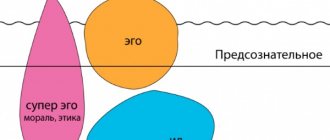Concept and meaning
Emotions are elementary experiences. They can occur under the influence of external or internal stimuli. The nature of the manifestation depends on the degree of satisfaction of one’s own desires and expectations.
Emotions play a huge role. Depends on your emotional state:
- career advancement;
- development of personal interests;
- communication with family;
- physical health.
If a person is depressed, health problems may begin and physical activity will decrease.
Types and characteristics
Psychologists distinguish several types of manifestations - emotions, affects, feelings, moods, stress, frustration. Each of them has certain characteristics.
Emotions
Complex mental phenomena. The most significant are stress, feelings, moods. Emotions can be distinguished from affects by their duration. Affects are short-term manifestations. Emotions can change your mental state for a long time.
Affects
Affects are powerful manifestations of psychological reactions. They can be compared to emotional outbursts that change the mental state for a short period of time. Examples of affects:
- horror;
- rage;
- anger;
- deep grief;
- wild joy;
- despair.
When affects arise, they completely take over the psyche. Such outbursts completely suppress the will. Affects are irresistible; they force a person to take some action, which often has bad consequences.
Feelings
Feelings are emotional processes that last longer than affects, but are less intense. They can manifest themselves in relation to any object, animal, or other person. Feelings motivate a person to take any action.
Moods
Moods are emotional processes that last longer than affects. The intensity is extremely weak. Such manifestations include boredom, neutrality, indifference, dissatisfaction, satisfaction.
Stress
Stress is an emotional state that arises as a reaction to various events and extreme influences. They arise due to failures, losses, a series of difficult life moments, conflict situations, and trials.
Stress is familiar to people who are engaged in responsible work and develop a business. They are constantly nervous and tension builds up, causing a nervous breakdown.
One of the well-known emotional states that is similar to prolonged stress is emotional burnout.
Frustration
Frustration occurs when plans are systematically destroyed, upset, or deceived. More often caused by insurmountable difficulties, barriers, difficulties that arise when achieving a certain goal.
Frustration is accompanied by negative feelings. They are capable of destroying activity and consciousness. Kinds:
- external, internal aggression;
- depression;
- bitterness;
- grief;
- dissatisfaction.
Frustration intensifies if failures constantly arise in different areas of life, others reproach the person for this, blame, humiliate, criticize.
Classification of cognitive mental processes
The basis for the classification of various cognitive mental processes and attention, which are: Properties of stimulus and modality - in the classification of sensations; the predominant role of the analyzer and the form of existence of matter is in the classification of perceptions; subject, memorization material, activity of the subject, duration of the process, leading analyzer - in the classification of memory features; leading analyzer, the degree of generalization of the image and content of the activity - in the classification of ideas, the degree of awareness and activity of the subject, the temporal orientation of the activity, the type of appearance of images, the type of activity, the specifics of mental activity - in the classification of imagination; The subject, the material of the activity, the type of connection with practice, the type of connections and reflected relationships, the content of the work - in the classification of the characteristics of thinking; the activity of the subject in organizing attention, the focus of attention on the external and internal world of a person, the object of attention, the leading analyzer - in the classification of features. A comparison of possible classifications of mental processes shows that there is no single approach to this problem. At all levels of mental reflection, only one criterion is presented - the leading analyzer. The remaining criteria serve as the basis for classifying only one or two or three processes. Therefore, it is necessary to select the most significant, significant grounds for classifications, which at the same time are the most general and are presented at all levels of consideration (actual or potential).
As a result, the following criteria for the classification of cognitive processes and attention were included: the leading analyzer, the subject of reflection, the form of existence of matter, the activity of the subject, the direction of reflection in space and time, the duration of the process, the nature of the activity (content of the work), the nature of the connection with practice. Let us consider each of the identified classification criteria in relation to individual mental processes. As mentioned above, the modality indicator is the most represented, however, the list of the main types of mental processes that are also distinguished by this parameter is far from complete. The functioning of the visual system is the most studied at all levels of cognition. This fact can be partially explained by objective reasons. The dominance of the visual system is due not only to “its own information material and the superiority of optical signals” over other types of signals, but also to the fact that “it plays the role of an internal communication channel between all analyzing systems (similar to a kinesthetic analyzer) and is a signal transducer organ.” It has now been established that the visual system functions at three levels: sensory (sensations), perceptual (perception) and apperceptive (ideas). Studies of “visual” thinking have proven the validity of this definition for the level of mental processes.
Functions
Psychologists identify a number of functions that emotions perform:
- Mobilization. This function manifests itself at the physiological level. The main manifestations are the release of adrenaline into the blood, dulling of sensations, narrowing of consciousness. The described manifestations help to discard unnecessary thoughts and act according to a specific situation.
- Grade. With the help of emotions, you can instantly assess the current situation or external stimulus. The emotional assessment appears before a detailed answer is composed. The first impression of a new person is extremely difficult to destroy.
- Compensation. Emotions can be called the highest order of intelligence. They do not go against reason. Psychologists call them a resource for solving various problems. For example, with the help of positive emotions you can strengthen needs, and with the help of negative ones you can reduce their effectiveness.
- Trace formation. Situations often happen when emotions appear too late, when everything is over, nothing serious can be changed. The created emotional effect is fixed in memory and will arise when similar situations arise.
- Communication. Emotions have an expressive component. They are transparent to society. For example, when one person expresses pain, the bitterness of loss, those around them have an altruistic motivation, a desire to help. Often such manifestations lead to new acquaintances, which can play a significant role in life.
What is a feeling?
In fact, a person’s feelings, like every emotion, are all relationships to what is happening, to what he encounters at every step in his life. A person cannot live a normal life without experiences. Feeling nothing, not experiencing emotional experiences, we are “emotionally hungry” and try to fill this hunger by listening to our favorite music, reading books, etc. At the same time, we need not only positive feelings for saturation, but also negative ones (associated with suffering).
Feeling is a manifestation of the life of the body. They live and have their own energy, filling our lives with meaning. Life is a constant movement, feelings are experiences of bodily energy. This energy can be used in different ways. You can swim in it, and also share it with the outside world and infect other people. Generally speaking, feelings are sensations, a whole complex of them.
Application of the Abraham Hicks scale to assess the condition
To create an accurate psychological description of a person’s emotional states and identify disturbances in the emotional sphere, you can use the Abraham Hicks scale. It can be used to describe a wide range of feelings - from negative to positive. Feelings on the scale are divided by color.
It is important to remember the feature of the scale. It is impossible to move along the scale from one side to the other without passing through intermediate stages. For example, it is impossible to go from suffering immediately to joy. Colors go from red to purple. The neutral zone, which is located in the center, is indicated in green.
Red zone
Manifestations:
- hopelessness;
- impotence;
- depression;
- despair;
- uncertainty;
- bitterness;
- envy;
- misfortune;
- humiliation;
- fear;
- shame;
- abandonment.
To move through the negative zone, you need to experience negativity, try to express it in order to move towards positive emotions.
Orange
The orange zone is less negative, but the sensations remain bad:
- fright;
- detachment;
- indignation;
- undervalued;
- anger;
- revenge;
- guilt;
- mistrust;
- resentment;
- hatred;
- discouragement.
It is important to be patient when navigating the different zones of the scale. To get rid of negative feelings, you can use natural psychological defense mechanisms, for example, shifting the blame to others. This helps to free yourself from negativity.
Yellow
This is an area of disappointment. Feelings:
- anxiety;
- sadness;
- disappointment;
- irritation;
- doubt;
- self-pity;
- loneliness;
- depression;
- anxiety;
- regret.
When passing through this and the next zone, psychologists recommend retuning to positive thoughts.
Green
Neutral zone. The main manifestation is boredom. Feelings become mixed as there is a transition between positive and negative emotions. The subject is unable to accurately describe his condition. He's not good, but he's not bad either. To him:
- boring;
- empty;
- Fine;
- indifferent.
At this stage, it is important to relax and try to renounce any feelings. You will feel temporarily tired. The person does not know what to do next. The main thing is not to give in to negativity. You need to try to rest.
Blue
At this stage, the subject begins to have hope. Characterized by:
- trust;
- value;
- nobility;
- fun;
- acceptance;
- interest.
Blue
With each stage the feelings will get better. At this stage, self-confidence appears. Its goal is to move from hope to faith. It is important to have the right mindset so that only good things happen. The blue zone is characterized by:
- confidence;
- approval;
- respect;
- anticipation of interesting events.
At this level a person feels security and satisfaction. He develops enthusiasm and strength to achieve his goals.
Purple
The last zone is purple. This stage is characterized by a feeling of invincibility. To feel global positive changes, you need to stay in this zone for at least three days in a row. If this condition persists for a month or more, your life position and train of thoughts will change. Most likely, material changes will occur - changing jobs, moving to a new place of residence, moving up the career ladder.
Analysis of types of mental processes
Studying the role of various analyzers in the process of cognition, B.G. Ananyev discovered that “such a combination is also present in the auditory system, which, however, functions at the last level (aerception) in specialized forms of speech and musical representations and does not have the ability to transform the signal.” However, the auditory system has been studied much less than the visual system.
The role of other analyzers in the processes of mental reflection has not yet been sufficiently studied; the statement about the intermodality of higher (per sensations) cognitive processes does not deny the need to study the role and specificity of the representation of each modality at different levels of cognition.
This position set us the task of supplementing the picture of the specifics of mental processes in terms of their modality, obtained as a result of an analysis of the literature. Considering that memory stores not only the results of perception of the surrounding reality, but also the results of sensations, we classified kinesthetic, tactile, pain, temperature, static-kinetic, organic and vibration memory as types of memory. Since representation and imagination are processes in which holistic images are recreated and processed, the types identified in them, in our opinion, should be similar to the types of perception, therefore they included visual, auditory, tactile, olfactory, gustatory and kinesthetic representations and imagination. To the specificity of thinking was added the auditory type of thinking, which was studied mainly in the form of musical thinking. Analysis of the types of mental processes according to the criterion “object of reflection” showed that this criterion “overlaps” for almost all levels of cognition. Therefore, we limited ourselves to the following transformations: Representation and imagination were divided into actual, motor and emotional imagination in accordance with the characteristics of the images present; conceptual imagination was excluded from the types of imagination, since it is only a postulated but completely unexplored characteristic of imagination; the object of reflection for perception and sensation was determined in accordance with the characteristics of objects and phenomena of the external, material world and the characteristics of man as a bearer of the subjective.
A special place is occupied by the criterion “form of existence of matter”, which is proposed for the classification of perception and is practically not used for the classification of other types of mental processes, although it is known that the main material that provides information about the properties of reality are the results of sensations and perceptions, which in turn serve source of functioning of the processes of memory, thinking, imagination. From this we can draw a completely natural conclusion that almost all individual modes of perception can have corresponding analogues for other cognitive processes. At the same time, the close and inextricable connection of all mental processes and the unity of the psyche as a system generate feedback between different levels of cognition.
As B.G. correctly noted. Ananyev, a person’s orientation in space and the structure of spatial perception express general features of mental development. It is no coincidence that recently many authors have been paying great attention to the study of the properties of spatial representation, imagination and thinking, the main material of which is spatial images directly related to a special type of perception - the perception of space. However, spatial memory, without which the functioning of both spatial imagination and spatial thinking is impossible, has not yet been practically studied.
The other side of cognitive processes associated with such a category as “time,” which has so far also been studied mainly at the level of perception, has been developed even less.










